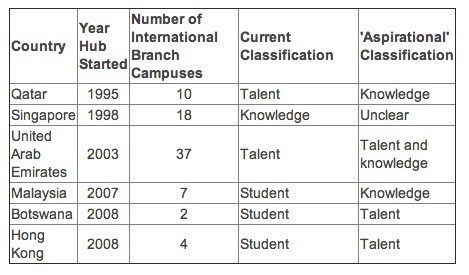A helpful approach to definition in this rather vague area
 An earlier post noted that there were rather a lot of ‘education hubs’ around the world. This Inside Higher Ed report on the recent Going Global event highlights comments from Jane Knight of the University of Toronto who has sought to define education hubs a little more precisely. Knight studied six hubs closely to assess their characteristics and proposed a simple schema for classifying hubs:
An earlier post noted that there were rather a lot of ‘education hubs’ around the world. This Inside Higher Ed report on the recent Going Global event highlights comments from Jane Knight of the University of Toronto who has sought to define education hubs a little more precisely. Knight studied six hubs closely to assess their characteristics and proposed a simple schema for classifying hubs:
While all may aim to attract foreign students and foreign branch campuses, they strive to be three main things, she said:
Student hubs, which seek to attract local and foreign students.
Talent hubs, which seek to develop the skilled people who will stay in the country.
Knowledge hubs, which seek to build research infrastructure.
Knight classifies her six hubs as follows:

Knight said that the goals for the hub influence who the players are — and that educators may not be the key players when a country is focused, for example, on becoming a knowledge hub. Rather, businesses or government officials who deal with immigration policy may become key players. She also said that thinking about goals also shifts away from simply counting the number of branch campuses — a figure that may be less important in some hubs.
While education hubs will continue to evolve, they represent an important “third stage” in transnational education, she said. The first was student mobility, with students leaving their homes for a postsecondary education. The second was institutional mobility, when colleges set up dual degrees or branch campuses in other countries. Hubs involve the first two stages, but take them to a new level, she said.
It’s a helpful approach, especially when you consider how many places do claim to be an education hub.










